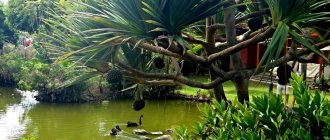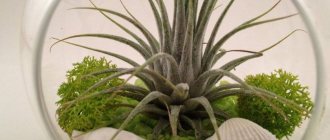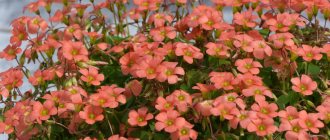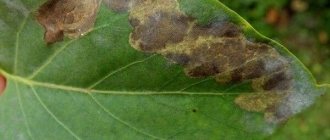Description and characteristics of culture
The Lydia variety bush has a neat compact shape, grows up to 60 cm. It is characterized by low susceptibility to fungal infections and insect pests.
External features of the rose:
- absence of thorns;
- leaves are oval, smooth, rich green in color;
- buds of deep pink color, about 4 cm in diameter;
- inflorescences include from 5 to 15 buds.
The varietal feature of the rose is abundant flowering, but this can only be achieved with proper care of the plant.
Rose spray - what is it, features, varieties, rules for planting and caring for the plant
Roses can be found in almost any garden, park, or summer cottage. Breeders are developing more and more varieties of them. One of the latest innovations is spray rose, which was obtained from the floribunda group at the end of the last century. This flower quickly gained popularity among professional florists and lovers of these amazing plants.
Rose spray - what is it?
Not only beginners, but also experienced flower growers often wonder, rose spray - what is it? This new variety, also called patio, has become especially popular recently. Incredibly beautiful, bright flowers with exquisite buds collected in brushes will be appropriate in any flower arrangements and landscape design. They look especially beautiful in a wedding bouquet as a background for larger flowers or as an independent mini-bouquet.
What does rose spray look like?
Queen of the garden, so this beautiful flower is deservedly called. Small spray rose bushes are compact and low-growing: they often grow up to 40-50 cm, although some varieties can be up to 1 m in height. Flowers of various shades, depending on the variety, can have a diameter from 3 to 7 cm. Since there can be up to 15 of them on a branch, spray roses are plants that are also called pink sprays. Flower buds can be densely double or goblet-shaped.
Features of rose spray
These plants have all the features of floribundas, except that the sprays are more compact and low-growing. These roses bloom long and profusely. In addition, they are unpretentious and very winter-hardy, which allows them to be grown in regions with cool climates. Rose spray has almost no thorns, which is especially convenient when caring for a plant or composing compositions. A small red or yellow spray rose grown in a pot or container looks impressive.
Advantages and disadvantages
Flower growers call the advantages of the Lydia variety:
- frost resistance;
- immunity to fungal pathologies and pests;
- inconsistency in cultivation;
- flowering throughout the growing season.
The only drawback that displeases some gardeners is the black core of the flower, which becomes noticeable when the petals are fully opened.
Overview of popular types
The Lydia variety includes 3 subvarieties.
Lovely Lydia
The most common variety of rose. The bush does not grow higher than 60 cm. The diameter of the buds is 4 cm. The color of the petals of the Love Lydia rose can be light pink with a cream tint or deep pink, almost crimson. When there is excessive light, the petals fade, causing the color of the buds to become less intense.
The subvariety is characterized by lush and long-lasting flowering, if the bush grows on fertile soil and does not suffer from lack of care.
Spray White Lydia
A compact bush, the height of which does not exceed 50 cm, suitable for container growing.
The inflorescences include 10-15 flowers of pale cream, almost white color. The bud has almost no smell and is 4-6 cm in diameter.
Floribunda Classic Lydia
A compact but voluminous bush, reaching a height of 60 cm and a width of 50 cm. For lush flowering, it requires an abundance of light, regular watering and a fertile substrate.
The buds are small, not exceeding 3 cm in diameter. The inflorescence includes 10-12 flowers. Petals are pale pink. Elastic stems may have rare thorns.
See also
Description and characteristics of roses of the Sahara variety, subtleties of cultivationRead
Rose Lovely Lidia
This variety of roses, bred by Dutch breeders, has all the qualities for which the group of spray roses is so famous.
The relatively low 60-70 cm bushes of this rose grow to 50-60 cm in diameter. The flowers of Lovely Lydia are small (only up to 4 cm in diameter), but they are distinguished by an unusual color, which varies from soft pink to bright crimson with pinkish or lilac tints. In the full bloom phase, the petals expose the dark core of the flower.
The rose is characterized by medium resistance to powdery mildew and blackleg and high resistance to gray rot. Without shelter, Lovely Lydia can tolerate frosts down to -23°C.
Subtleties of cultivation
Even an inexperienced gardener can cope with planting a Lydia rose. Growing the crop is hassle-free; the main thing is to follow the watering and fertilizing regime.
When they plant
Roses are planted in the second half of spring, when the soil thaws after winter and is thoroughly warmed by the spring sun.
Site selection
For the Lydia rose, choose a lighted place, but not an open one. The bush should not be exposed to direct sunlight. The best option is an area with openwork penumbra. Also, the chosen location should be protected from drafts and strong winds.
Preparation of planting material
The selected rose seedling must be carefully examined. The plant should be free of damage, signs of rot and fungal infection.
Before the planting procedure, the shoots of the seedling are pruned. Buds, injured and dried branches are also cut off. There should be 4-5 buds left on the main shoots. Secondary branches must have at least 3 buds. You also need to remove weak and broken roots and shorten the side roots a little.
To make the cuts heal faster, they are lubricated with garden varnish. Next, the seedling is placed in a container with an aqueous solution of sodium humate for half a day.
Planting scheme
The planting hole is prepared in the fall. The area chosen for planting is cleared of weeds, and the roots remaining from other plants are removed.
If other species of the Rosaceae family, a hawthorn bush, a cherry or quince tree previously grew on the site, then it is advisable to remove 50 cm of the top soil layer and replace it with a new one. Otherwise, the rose will be weak due to lack of nutrition.
The soil on the site is dug up to the depth of a shovel blade. Lumps of soil are turned over, but not broken. This will help destroy soil pests and fungal infections during the winter cold. Break up lumps and level the soil in the spring.
The Lydia rose is planted according to the following algorithm:
- dig a shallow planting hole (45x45 cm);
- the bottom is filled with drainage, a mixture of expanded clay, gravel, and sand is made;
- top dressing is placed on top, consisting of humus, peat, and rotted manure;
- the rose is placed in the hole so that the grafting area is immersed in the ground to a depth of 2 cm;
- the roots are straightened, the seedling is covered with earth;
- the surface of the soil is lightly compacted, the bush is watered abundantly (8 liters of water per plant).
Growing and care
The crop should be planted in the area of the site where partial shade reigns most of the day. Full shade is not suitable for its cultivation, otherwise you will not see the excellent flowering of the ornamental perennial in all its glory. To plant the Dutch variety, it is recommended to use loose, light, slightly acidic soil rich in humus. A layer of a mixture consisting of small pebbles and sand is placed at the bottom of the hole, 40 cm deep, so that water does not stagnate when watering the plant. Then organic fertilizer is added to the planting hole. You can also add some chopped oak bark. Only after this comes the turn of the soil. And then they start planting roses. When this procedure comes to an end, the soil around the plant should be compacted slightly and the crop should be watered generously.
Decorative perennials need complete comprehensive care, consisting of:
- regular moistening of the soil under the flower with settled, not cold water;
- fertilizing with nitrogen and phosphorus-potassium fertilizers throughout the entire growing season;
- loosening and mulching the soil in the tree trunk area;
- mandatory pruning of shoots.
Loosen the soil under the rose bush no earlier than a day after watering. Straw or shredded tree bark can be used as mulch.
In the spring, the bush is pruned in order to rid it of dried, frozen and too weak, thin, and therefore non-viable branches. Strong stems are shortened a little. In the summer, it is important to promptly remove dried inflorescences and stems that contribute to thickening of the bush, and to perform formative pruning. In autumn, pruning is carried out on all shoots without exception. After completing the steps, the crop is covered with dry soil and covered with spruce branches or more serious insulation in the case of growing a perennial in an area with extremely cold winters.
Among the pests, the variety can be damaged by spider mites, thrips and aphids. To prevent their appearance on the plant, the shoots of the rose bush are treated with an insecticide solution several times a season.
Nuances of flower care
Rosa Lydia is not capricious in terms of care. It is enough to follow standard agrotechnical procedures: water and feed the plant, form a crown, put up a shelter for the winter.
Watering
Water the rose regularly: 2-3 times a week. If it is hot, then additionally spray the crown.
Top dressing
The roots of the rose become stronger by the age of 3; before that, it is not recommended to apply fertilizer to the bush.
See also
Description and characteristics of the Sphinx rose, planting and care rulesRead
Feeding is carried out:
- in spring – with a nitrogen preparation;
- in summer - potassium-phosphorus complex.
When the buds form, it doesn’t hurt to fertilize the rose with manure.
Trimming
Pruning a rose for:
- formation of shoots;
- ensuring more luxuriant and longer flowering.
The procedure is carried out three times a season:
- in the spring, cut off shoots up to 12-15 cm, leave 2-3 buds on the main shoots, 1-2 on secondary ones;
- in summer, they rid the plant of withered branches and faded buds;
- In the fall, cut off diseased and weak branches.
Wintering
Despite its winter hardiness, rose Lydia needs winter insulation. Insulation is installed if the night air temperature in winter falls below -8 °C. Spruce paws are used as covering material. A frame is placed on top, which should be 20 cm higher than the plant. It is covered with plastic film or agrofibre.
In early spring, the insulation is periodically opened for ventilation. And with the arrival of constant heat they are removed.
The nuances of growing in open ground
For a long time, Siberian flower growers did not dare to cultivate heat-loving crops in the garden, but with the advent of frost-resistant varieties, they began to try to grow roses in open areas. Many people succeeded.
Landing dates
In order for the flower to grow in the climate of Siberia, which is characterized by a late spring and frosts starting early, a climbing rose must be planted when the ground warms up well and the dandelions bloom. And this usually occurs no earlier than the end of May.
Selecting a location
It is also possible to create comfortable conditions for roses in climates where summers are short and the sun does not rise as high above the horizon as in the south. When choosing a place for a plant, you need to consider some nuances:
- Roses should not be planted in lowlands where the soil freezes deeply in winter.
- It is better to place the crop not in the sun, but in light partial shade.
- The area for the flower should be protected from cold winds blowing from the north or east.
Climbing varieties decorate buildings, but to prevent the plant from becoming frozen and dying, it is planted at least a meter from the wall. The rose does not tolerate stagnant water, looks harmonious, and feels good next to coniferous trees and shrubs, irises and clematis.
Preparation of planting material
You need to buy roses from a local nursery, which sells varieties adapted to natural conditions. You need to choose a seedling for growing that has strong roots and shoots and a green stem. In order for the rose to quickly settle into a new place and recover from the resulting stress:
- Potassium permanganate powder is poured into the water, and the roots are placed in the prepared solution for a day.
- Soak the flower in the growth stimulator “Zircon”.
- The shoots of the plant are shortened by 20 cm, damaged branches and dried areas of roots are removed.
Shortly before planting, the sections are wiped with Fundazol. Roses that are sold in a package with a lump of soil are placed in the soil along with a container that is made of a material that dissolves in the soil.
Landing rules
The area for the climbing rose is dug up, leveled, and the weeds are removed along with the roots. The acidic soil is diluted with ash or dolomite flour, and a hole is made for the seedling up to 0.8 m deep:
- A thick layer of fine crushed stone or expanded clay is poured onto the bottom, and river sand is added on top.
- Combine humus, peat and garden soil.
- The hole is filled to a third with the nutrient mixture, 2-3 tablespoons of superphosphate and one potassium salt are added.
- The rose is placed vertically in a hole, the roots are straightened and buried 10 centimeters below the surface.
- Supporting the bush with your hand, fill the space.
The seedling is irrigated with warm water. The soil is compacted around the plants and a small rampart is built. For the first 2 weeks, the young rose is protected from the sun's rays.
Diseases and pests
The Lydia variety is immune to infectious pathologies and insects, subject to proper care. A rose gets sick if it is adjacent to weeds and diseased vegetation, and also if the owner does not take care of it.
Rose can be affected by:
- Spider mite. To combat it, the insecticide Fitoverm is used. For prevention, the plant is regularly inspected for the presence of cobwebs, and spraying is carried out in hot weather.
- Aphid. If there is not much of it, then just wash the plant with soapy water. If the lesion is advanced, then you will have to use insecticides - Karbofos, Actellik.
- Powdery mildew is a fungal infection that develops under excess humidity and low temperature. To combat the disease, spray with 0.5% soda ash. Bordeaux solution is used for prevention.
Diseases, pests and ways to combat them
No matter what they say, there are no roses that are absolutely resistant to diseases and pests. Despite the average resistance of Lydia spray rose, infectious diseases such as:
- gray rot;
- powdery mildew;
- black spot;
- viral mosaic.
Border rose Lovely Lydia, improperly planted and therefore weakened, may suffer from disease. Pathogens (bacteria, viruses) actively multiply in shady, dense places. To prevent the development of infectious diseases, preventive spraying with iron sulfate or systemic fungicides is carried out.
Pests can also be annoying: spider mites, roseate aphids, golden bronzes. In case of severe pest infestation, treat with actara or actelik. If there are few beetles and caterpillars, they are collected by hand, preferably early in the morning.
A description of the Lovely Lydia variety and tips on propagation and care will help you choose and grow this particular wonderful variety. Don't be afraid to create beauty, it's very exciting!
How to propagate the plant
Rose Lydia is propagated by cuttings. The procedure is carried out in the summer months. Select the lower shoots with 3-4 leaves and cut them obliquely so that the cut has an angle of 45°. The cutting should have one leaf and 2 buds at the bottom.
A rose is cut according to the following algorithm:
- the cutting is placed in a root growth stimulator solution for 2 hours;
- then planted in a container filled with peat and sand mixed in a ratio of 3:1;
- the substrate is moistened, the container is covered with polyethylene to form a greenhouse effect;
- The film is periodically removed for ventilation.
The young plant is pruned the following year in the spring. Leave the main shoots with 2-4 buds and cut them to about 15 cm.
Flower propagation
It is best to take rose cuttings from May to August. To do this, you need to cut a branch with several pairs of leaves obliquely and place it in water until the root system forms. It is advisable to first immerse it in the root solution for 2-3 hours. As soon as the roots appear, you need to plant the cuttings in a pot with peat or sand. It is necessary to cover the sprout with plastic wrap and periodically open it for ventilation and remove accumulated condensation. When the shoot gets stronger, it can be planted in the ground.











